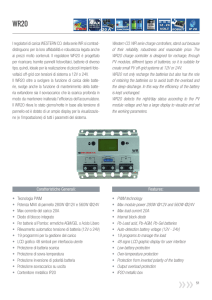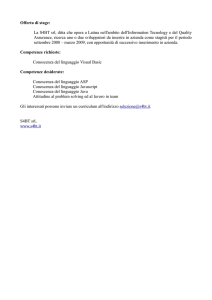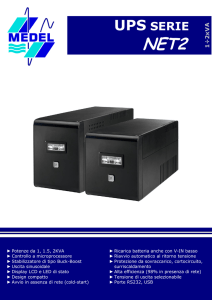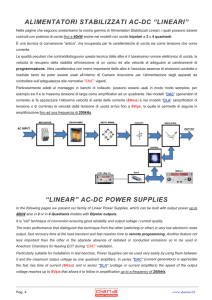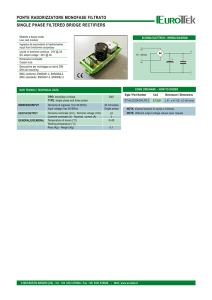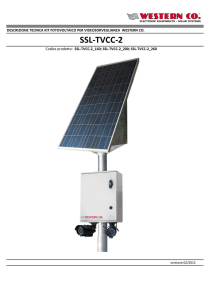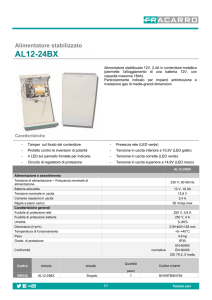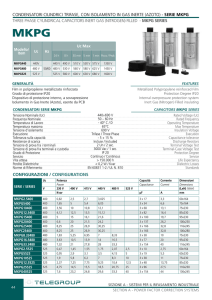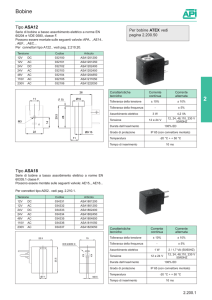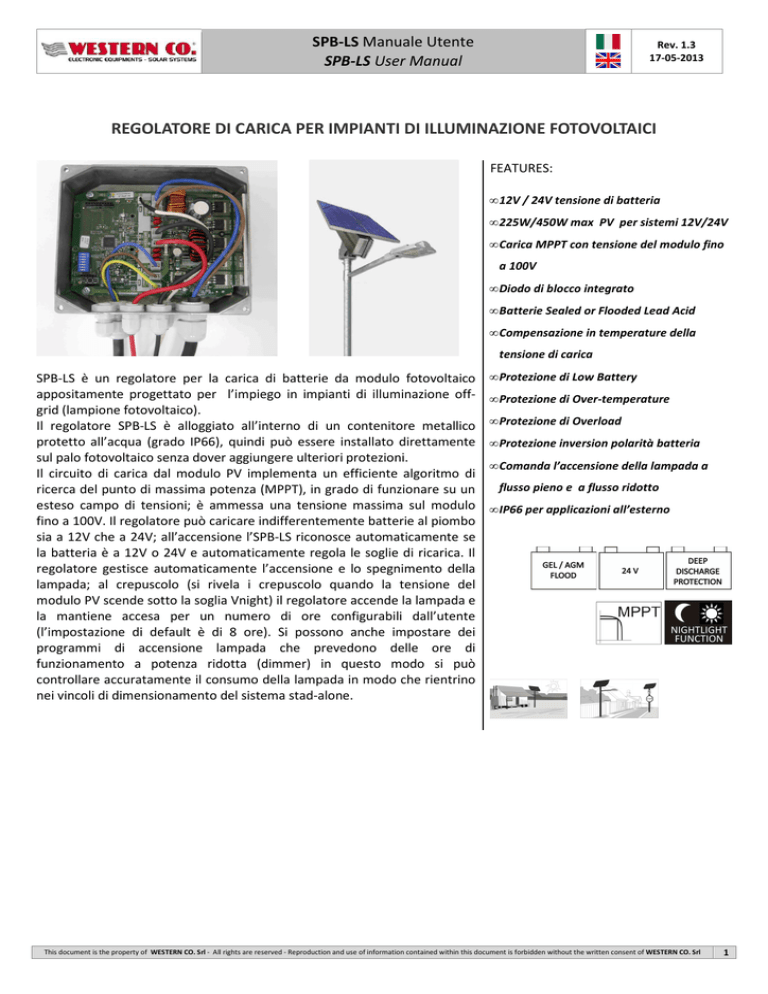
SPB-LS Manuale Utente
SPB-LS User Manual
Rev. 1.3
17-05-2013
REGOLATORE DI CARICA PER IMPIANTI DI ILLUMINAZIONE FOTOVOLTAICI
FEATURES:
• 12V / 24V tensione di batteria
• 225W/450W max PV per sistemi 12V/24V
• Carica MPPT con tensione del modulo fino
a 100V
• Diodo di blocco integrato
• Batterie Sealed or Flooded Lead Acid
• Compensazione in temperature della
tensione di carica
SPB-LS è un regolatore per la carica di batterie da modulo fotovoltaico
appositamente progettato per l’impiego in impianti di illuminazione offgrid (lampione fotovoltaico).
Il regolatore SPB-LS è alloggiato all’interno di un contenitore metallico
protetto all’acqua (grado IP66), quindi può essere installato direttamente
sul palo fotovoltaico senza dover aggiungere ulteriori protezioni.
Il circuito di carica dal modulo PV implementa un efficiente algoritmo di
ricerca del punto di massima potenza (MPPT), in grado di funzionare su un
esteso campo di tensioni; è ammessa una tensione massima sul modulo
fino a 100V. Il regolatore può caricare indifferentemente batterie al piombo
sia a 12V che a 24V; all’accensione l’SPB-LS riconosce automaticamente se
la batteria è a 12V o 24V e automaticamente regola le soglie di ricarica. Il
regolatore gestisce automaticamente l’accensione e lo spegnimento della
lampada; al crepuscolo (si rivela i crepuscolo quando la tensione del
modulo PV scende sotto la soglia Vnight) il regolatore accende la lampada e
la mantiene accesa per un numero di ore configurabili dall’utente
(l’impostazione di default è di 8 ore). Si possono anche impostare dei
programmi di accensione lampada che prevedono delle ore di
funzionamento a potenza ridotta (dimmer) in questo modo si può
controllare accuratamente il consumo della lampada in modo che rientrino
nei vincoli di dimensionamento del sistema stad-alone.
• Protezione di Low Battery
• Protezione di Over-temperature
• Protezione di Overload
• Protezione inversion polarità batteria
• Comanda l’accensione della lampada a
flusso pieno e a flusso ridotto
• IP66 per applicazioni all’esterno
This document is the property of WESTERN CO. Srl - All rights are reserved - Reproduction and use of information contained within this document is forbidden without the written consent of WESTERN CO. Srl
1
SPB-LS Manuale Utente
SPB-LS User Manual
Rev. 1.3
17-05-2013
Wiring
Configuration
switch
Fig. 2 Wiring scheme
This document is the property of WESTERN CO. Srl - All rights are reserved - Reproduction and use of information contained within this document is forbidden without the written consent of WESTERN CO. Srl
2
SPB-LS Manuale Utente
SPB-LS User Manual
Rev. 1.3
17-05-2013
Visualizzazioni e protezioni:
Led PV
Verde
Funzionalità
Il numero di lampeggi effettuati indica l’’intensità di corrente dal
modulo fotovoltaico.
1 flash con pausa di 4,3 sec.: 0,5A < PV current < 1,5A
2 flash con pausa di 4,3 sec.: 1,5A < PV current < 2,5A
e cosi via…
…valori intermedi…
13 flash con pausa di 4,3 sec.: 12,5A < PV current < 13,5A
Led Status Funzionalità
Rosso
Led 12/24 Funzionalità
Verde
Indica lo stato del sistema
Se sempre acceso indica un’anomalia del sistema che richiede un
reset.
1 flash ogni 2,2 secondi: protezione di Low-Battery attiva; carico
disattivato; occorre attendere che il modulo PV ricarichi la batteria
dopodiché la protezione si disattiva. (condizione di normale
funzionamento)
2 flash ogni 2,2 secondi: protezione di sovraccarico attiva; carico
disattivato; dopo circa due minuti si autoripristina esegue tre
tentativi in sequenza dopodiché aspetterà la notte successiva per
riprovare.
3 flash ogni 2,2 secondi: protezione di sovratemperatura; carico
disattivo e circuito di ricarica disattivato; occorre attendere che la
temperatura interna al contenitore diminuisca dopodiché la
protezione si disattiva.
4 flash ogni 2,2 secondi: protezione di sovratensione; circuito di
ricarica disattivato; la protezione si disattiverà quando la tensione
di batteria rientra nel range operativo.
Indica la tensione nominale di funzionamento del sistema
Oltre all’indicazione della tensione nominale di funzionamento del
sistema, se ogni 4,3sec si spegne per un attimo indica che la sonda
NTC e disconnessa. La Vch equivale a quella per 60°C
Programmazione LOAD:
La programmazione del carico è
eseguita attraverso i ‘configuration
switch’. Il simbolo luna in
corrispondenza della prima ora
indica l’evento crepuscolo. Ogni
casellina rappresenta un’ora (da 1 a
16): se colorata interamente o
parzialmente
l’uscita
“LOAD”
risulterà attiva; l’uscita “Dimmer”
sarà attiva solo se la casellina è
colorata
parzialmente
(a
rappresentare la riduzione di
flusso). La prima configurazione
“AUTOMANAGEMENT”
provvede
automaticamente a variare le ore di
ridotta in base all’energia disponibile in batteria. Nella configurazione 24 HOURS TO DAY il LOAD è sempre attivo
indipendentemente se giorno o notte.
Quando l’impostazione self-management è in ON il regolatore SPB-LS sceglie in modo automatico l’impostazione
ProgTimer. Un algoritmo proprietario della Western Co, basato sull’energia prodotta giornalmente dal modulo PV, setta
il ProgTimer in modo da usare tutta l’energia giornaliera prodotta dal modulo PV riducendo il rischio che il sistema vada
in protezione di low battery. L’algoritmo self-management imposta 12 ore di accensione lampada ma incrementa o
decrementa il numero di ore in riduzione di flusso come nella seguente tabella:
This document is the property of WESTERN CO. Srl - All rights are reserved - Reproduction and use of information contained within this document is forbidden without the written consent of WESTERN CO. Srl
3
SPB-LS Manuale Utente
SPB-LS User Manual
Alla prima attivazione del Self-management,
l’SPB-LS seta il ProgTimer:
Se il sistema incontra alcuni giorni di bel tempo
allora questo incrementa il numero di ore di
accensione alla massima luminosità.
Rev. 1.3
17-05-2013
dopo 1 day
dopo 2 days
dopo 3 days
…..
Se il sistema incontra alcuni giorno di cattivo
tempo questo decrementa le ore alla massima
lumiosità.
after 1 day
after 2 days
after 3 days
…
Minimum
Funzionamento:
L’ SPB-LS è un regolatore di carica da moduli fotovoltaici per batterie elettrochimiche al piombo di tipo ermetico (SEAL)
o ad acido libero (FLOOD). In fig. 1 è riportato uno schema di principio.
(1)-Circuito di ricarica: adatta la VPAN e la IPAN (rispettivamente tensione e corrente del modulo fotovoltaico) in modo da
ricercare la condizione in cui la potenza erogata dal modulo PV è massima, realizzando quello che nella letteratura
tecnica è indicato con la sigla MPPT (Maximum
Power Point Tracking). Inoltre gestisce la ricarica
SPB-LS
1
IP AN
IBATT
della batteria riducendo la corrente erogata verso la
MPPT
batteria nelle condizioni in cui la tensione VBATT
supera la sua tensione di ricarica (VCH).
4
(2)-Diodo di blocco: serve ad evitare che durante la
MICROCON TROL LER
notte, quando il modulo fotovoltaico non è illuminato
VP AN
V BATT
V L OAD
questo possa assorbire corrente dalla batteria.
(3)-Circuito per il controllo del carico: accende o spegne
D IMMER
3
2
il carico secondo il programma impostato dall’utente,
comanda la segnalazione Dimmer, e provvede al
ILO AD
distacco del carico in caso di batteria scarica o
F ig. 2 sche ma di principio
sovraccarico.
(4)-Microcontrollore: controlla l’intero circuito, misura le correnti e tensioni del modulo della batteria e del carico,
esegue l’algoritmo MPPT.
This document is the property of WESTERN CO. Srl - All rights are reserved - Reproduction and use of information contained within this document is forbidden without the written consent of WESTERN CO. Srl
4
SPB-LS Manuale Utente
SPB-LS User Manual
Rev. 1.3
17-05-2013
Scelta del modulo fotovoltaico:
Il regolatore di carica SPB-LS, grazie al circuito di ricarica con MPPT, permette di impiegare una ampia gamma di moduli
fotovoltaici garantendo lo sfruttamento ottimale di tutta la potenza. Il modulo PV va scelto a seconda della tensione
nominale della batteria e rispettando i vincoli dell’ingresso pannello del SPB-LS: massima tensione a circuito aperto:
100V e massima potenza di pannello 225W con batteria a 12V e 450W con batteria 24V.
Tensione
nominale
Caratteristiche moduli PV
batteria
Vmp: tensione alla massima potenza a T=25°C >
15,0V
VOC: tensione circuito aperto a T=-10°C <100V
IPAN
Tensione nominale
PMAX: massima potenza a 25°C < 225W
Consigliamo moduli al silicio mono o poly-cristallino con numero di celle da minimo 36 a massimo 144 celle.
batteria 12V
Vmp: tensione alla massima potenza a T=25°C >
VPAN 30,0V
VOC: tensione circuito aperto a T=-10°C <100V
Vmp VOC
Tensione nominale
PMAX: massima potenza a 25°C < 450W
batteria 24V
Consigliamo moduli al silicio mono o polycristallino con numero di celle da minimo 72 a
massimo 144 celle.
Installazione regolatore SPB-LS
1)Posizionare il regolatore sul palo fotovoltaico, con i pressa cavo rivolti verso il basso. Se avete acquistato una struttura
testa-palo della Western Co tipo WTP55 o WTP20, questa è già predisposta per alloggiare il regolatore SPB-LS.
2)Eseguire i cablaggi della lampada, del modulo PV e della batteria come nello schema a pag.2. Insieme al regolatore
SPB-LS sono forniti in dotazione tutti i cavi necessari a fare i collegamenti interni del lampione PV.
3)Deve essere impostata la configurazione per le batterie.
Spostare lo switch n°5 alla posizione ON se le batterie sono situate vicino al regolatore (come nel testapalo completo)
mentre posizionarlo a OFF se le batterie sono lontane dal regolatore.
Spostare lo switch n°6 selezionando il tipo di batteria in uso per adeguare la corretta tensione di ricarica (Vch ). Si deve
impostare la configurazione SEAL se si usano batteria ermetiche VRLM o di tipo GEL, mentre si deve scegliere la
configurazione FLOOD se si usano batterie ad acido libero.
Spostare lo switch n°7 selezionando la profondità di scarica del banco batteria tra 30% e 70%. Ciò determina
l’autonomia del sistema in assenza di sole con 70% avremo un’autonomia maggiore, ma la vita attesa del banco batteria
si riduce. Consigliamo generalmente una DoD del 30%.
Impostare tramite gli switch n°1-2-3-4 il programma di gestione del carico adeguato alla propria applicazione.
Collaudo impianto:
Appena messo in funzione il sistema procedere al collaudo:
• Con il modulo PV esposto al sole, verificare che l’ SPB-LS ricarichi la batteria osservando il led PV che indica
l’intensità di corrente dal modulo PV. Effettuerà dei lampeggi come da tabella.
• Verificare che il led 12V/24V non indichi la disconnessione della sonda NTC (vedi tabella precedente).
• Verificare la corretta accensione del carico (spostando momentaneamente gli switch 1-2-3-4 tutti a OFF: carico
sempre acceso); oppure è possibile simulare la notte scollegando temporaneamente uno dei fili del modulo PV
o ancora oscurando il modulo PV con un pannello coprente.
This document is the property of WESTERN CO. Srl - All rights are reserved - Reproduction and use of information contained within this document is forbidden without the written consent of WESTERN CO. Srl
5
SPB-LS Manuale Utente
SPB-LS User Manual
Rev. 1.3
17-05-2013
Dimensioni
This document is the property of WESTERN CO. Srl - All rights are reserved - Reproduction and use of information contained within this document is forbidden without the written consent of WESTERN CO. Srl
6
SPB-LS Manuale Utente
SPB-LS User Manual
Grafico 1
Rev. 1.3
17-05-2013
Grafico 2
SPECIFICHE TECNICHE
Tensione di batteria
Vbatt
Tensione di pannello a circuito aperto
Vpan
Corrente di pannello
Ipan
Massima potenza di pannello
Pmax
Tensione uscita carico
Vload
Corrente del carico
Iload
Tensione di ricarica a 25°C
Vch
SW_6->SEAL
SW_6->FLOOD
Compensazione della Vch in funzione della Vtadj
temperatura di batteria (Tbatt) (vedi Grafico 1)
Tensione di Low battery SW_5->ON
Vlb
SW_7->ON
SW_7->OFF
Compensazione della Vch con SW_5->OFF (vedi Vremch
Grafico 2)
Tensione uscita Low battery a 25°C
Vout_lb
Compensaione della Vlb con SW_5->OFF (vedi Vremlb
Grafico 2)
Tensione rilevazione giorno (impostabile)
Vday
Tensione rilevazione notte: Vnight = Vday –0.8V
Vnight
Auto consumo
Iqsc
Temperatura ambiente di esercizio
Tamb
Grado di protezione
Peso
Dimensioni scatola (mm)
Ingombro con cavi (mm)
Tensione nominale batteria
12V
Min
Typ
Max
10V
12V
17V
20V
100V
13,5A
225W
Vbatt
8A
-
14.44V
14.88V
24mV/°C
12.00V
11.52V
+58mV/A
Tensione nominale batteria
24V
Min
Typ
Max
20V
24V
34V
40V
100V
13,5A
450W
Vbatt
8A
-
-
-
-
28.88V
29.76V
48mV/°C
24.00V
23.04V
+58mV/A
-
-
Vch-0,24V
58mV/A
-
-
Vch-0,48V
-58mV/A
-
-
6.88V
4.48V
12.7mA
-
-
11.36V
8.96V
17,7mA
-
50°C
-10°C
160x135 H65
160x170 H65
-
-10°C
-
IP66
1.0Kg
50°C
IP66
1.0Kg
-
This document is the property of WESTERN CO. Srl - All rights are reserved - Reproduction and use of information contained within this document is forbidden without the written consent of WESTERN CO. Srl
7
SPB-LS Manuale Utente
SPB-LS User Manual
Rev. 1.3
17-05-2013
Garanzia di legge
Western Co srl garantisce la buona qualità e la buona costruzione dei Prodotti obbligandosi, durante il periodo di
garanzia di 5 (cinque) anni, a riparare o sostituire a sua sola discrezione, gratuitamente, quelle parti che, per cattiva
qualità del materiale o per difetto di lavorazione si dimostrassero difettose.
Il prodotto difettoso dovrà essere rispedito alla Western Co srl o a società delegata dalla Western Co srl a fare assistenza
sul prodotto, a spese del cliente, assieme ad una copia della fattura di vendita, sia per la riparazione che la sostituzione
garantita. I costi di re-installazione del materiale saranno a carico del cliente.
La Western Co srl sosterrà le spese di re spedizione del prodotto riparato o sostituito.
La garanzia non copre i Prodotti che, in base a nostra discrezione, risultino difettosi a causa di naturale logoramento,
che presentino guasti causati da imperizia o negligenza del cliente, da imperfetta installazione, da manomissioni o
interventi diversi dalle istruzioni da noi fornite .
La garanzia decade altresì in caso di danni derivanti da:
-trasporto e/o cattiva conservazione del prodotto.
-causa di forza maggiore o eventi catastrofici (gelo per temperature inferiori a -20°C, incendio, inondazioni, fulmini, atti
vandalici, ecc…).
Tutte le sopraccitate garanzie sono il solo ed esclusivo accordo che soprassiede ogni altra
proposta o accordo verbale o scritto e ogni altra comunicazione fatta tra il produttore e l’acquirente in rispetto
a quanto sopra.
Per qualsiasi controversia il Foro competente è Ascoli Piceno.
Smaltimento dei rifiuti
La Western Co in qualità di produttore del dispositivo elettrico descritto nel presente
manuale, ed in conformità al D.L 25/07/05 n 151, informa l’acquirente che questo
prodotto, una volta dismesso, deve essere consegnato ad un centro di raccolta
autorizzato oppure, in caso di acquisto di apparecchiatura equivalente può essere
riconsegnato a titolo gratuito al distributore della apparecchiatura nuova.
Le sanzioni per chi abusivamente si libera di un rifiuto elettronico saranno applicate
dalle singole amministrazioni comunali.
MADE IN ITALY
Western Co. s.r.l.
Via Pasubio, 1
San Benedetto del Tronto (AP)
63074 - Italy
[email protected]
www.western.it
This document is the property of WESTERN CO. Srl - All rights are reserved - Reproduction and use of information contained within this document is forbidden without the written consent of WESTERN CO. Srl
8
SPB-LS Manuale Utente
SPB-LS User Manual
Rev. 1.3
17-05-2013
CHARGE REGULATOR FOR PV LIGHTING SYSTEMS
FEATURES:
• 12V / 24V battery voltage system
• 225W/450W max PV power for 12V/24V
systems
• MPPT charge with module voltage up to
100V
• Integrated blocking diode
• Sealed or Flooded Lead Acid Battery
• Temperature compensation of charge
SPB-LS is a charge regulator for the charge of batteries from PV module; it
has been specially designed for the use in off-grid PV lighting systems (PV
street-lamp). The charge controller code SPB-LS is housed inside a metal
box that is protected from water (IP66 degree); therefore it can be installed
directly on the PV pole without having to add additional protections.
The charge circuit from PV module has got an efficient algorithm for the
search of the maximum power point (MPPT) that is capable of operating
over an extended field of voltages. It is allowed a maximum voltage on the
PV module up to 100V. The regulator can charge either 12V Pb batteries or
24V Pb batteries. On power ON, SPB-LS automatically recognizes if the
battery is at 12V or 24V and it automatically adjusts the charge thresholds.
The regulator automatically manages the power on and off of the lamp.
At dusk (when the voltage of the PV module drops below the Vnight
threshold) the charge controller switches on the lamp and keeps it on for a
number of hours that can be set by the user (the default setting is 8 hours).
You can also set some programs for lamp’s power on with working hours
with reduced flux (dimmer). In this way you can check accurately the lamp
consumption so to remain inside the dimensioning of the PV off-grid
system.
voltage
• Low Battery Protection
• Over-temperature Protection
• Overload Protection
• Protection for battery polarity inversion
• Lamp power on at full flux and reduced
flux
• IP66 for Outdoor Applications
This document is the property of WESTERN CO. Srl - All rights are reserved - Reproduction and use of information contained within this document is forbidden without the written consent of WESTERN CO. Srl
9
SPB-LS Manuale Utente
SPB-LS User Manual
Rev. 1.3
17-05-2013
Wiring
Configuration
switch
Fig. 2 Wiring scheme
This document is the property of WESTERN CO. Srl - All rights are reserved - Reproduction and use of information contained within this document is forbidden without the written consent of WESTERN CO. Srl
1
0
SPB-LS Manuale Utente
SPB-LS User Manual
Rev. 1.3
17-05-2013
Displaying and Protections:
PV LED
Green
Functionality
The number of flashes indicates the intensity of current from the PV
module
1 flash with a pause of 4,3 sec.: 0,5A < PV current < 1,5A
2 flashes with a pause of 4,3 sec.: 1,5A < PV current < 2,5A
and so on…
…intermediate values…
13 flashes with a pause of 4,3 sec.: 12,5A < PV current < 13,5A
Status LED Functionality
Red
It indicates the system status
If always ON it indicates a system anomaly – a reset is needed.
12/24 LED Functionality
Green
1 flash every 2,2 seconds: the Low-Battery protection is ON; the
load is deactivated; you have to wait that the PV module recharges
the battery and, after that, the protection deactivates (condition of
normal working).
2 flashes every 2,2 seconds: the Overload protection is ON; the load
is deactivated; after about 2 minutes the load is restored; it makes
3 attempts in sequence; then it will wait the following night to try
again.
3 flashes every 2,2 seconds: Over-temperature protection; load
OFF and deactivated charge circuit; wait that the temperature
inside the box decreases, then the protection will deactivate.
4 flashes every 2,2 seconds: Overvoltage protection; the charge
circuit is deactivated; the protection will deactivate when the
battery voltage goes back within its operative range.
It indicates the working nominal voltage of the system
In addition to the working nominal voltage of the system, if every
4,3 seconds it switches off for a moment, this means that the NTC
probe is disconnected. Vch is equivalent to that for 60°C.
LOAD programming:
Load programming can be executed
through ‘configuration switches’.
The
“moon”
symbol
in
correspondence of the first hour
indicates the “sunset” event. Each
box represents an hour (from 1 to
16): if it is entirely or partially
colored the “LOAD” output is active;
the “Dimmer” output is active only
if the box is partially colored (to
represent the flux reduction).
The
first
configuration
(“AUTOMANAGEMENT”)
will
automatically change the hours of
reduced flux according to the
energy available inside the battery.
In the configuration: 24 HOURS TO DAY the LOAD is always active regardless of whether day or night.
when self-management is in ON, the SPB-LS/GSM chooses the most suitable timer. A Western Co proprietary algorithm,
based on the daily energy produced by the PV module, it sets the ProgTimer in order to use all the daily energy
produced by the module without the risk that the system goes into low battery protection. The self-management
algorithm sets the lamp on for 12 hours but can increase or decrease the number of hours at low flow as in following
table.
This document is the property of WESTERN CO. Srl - All rights are reserved - Reproduction and use of information contained within this document is forbidden without the written consent of WESTERN CO. Srl
1
1
SPB-LS Manuale Utente
SPB-LS User Manual
At the activation of Self-management, SPBLS/GSM sets ProgTimer:
If the system detects a few days of good weather
it increases the hours at maximum flux..
Rev. 1.3
17-05-2013
after 1 day
after 2 days
after 3 days
…..
Maximum
If the system detects a few days of bad weather
it decreases the hours at maximum flux..
after 1 day
after 2 days
after 3 days
…
Minimum
Working:
SPB-LS is a PV charge controller for either electrochemical sealed batteries (SEAL) or flooded lead acid (FLOOD).
Fig. 1 shows a principle diagram.
(1)-Charge circuit: it adapts VPAN and IPAN (respectively voltage and current of PV module) in order to search the
condition in which the power delivered by the PV
module is maximum, realizing what is indicated in the
SPB-LS
1
I
P
AN
I
BATT
technical literature with the acronym MPPT
MPPT
(Maximum Power Point Tracking). In addition, it
manages the battery charge by reducing the current
4
delivered to the battery when VBATT voltage exceeds
MICROCON TROL LER
its charging voltage (VCH).
VP AN
V BATT
VL OAD
(2)-Blocking diode: it is needed to avoid that during the
night, when the PV module is not lighted, this can
D IMMER
3
2
absorb current from the battery.
(3)-Circuit for the load control: it switches ON/OFF the
ILO AD
load according to the program set by the user, it
Fig. 2 Principle diagram
commands the “Dimmer” signaling and it disconnects
the load in case of low battery or overload.
(4)-Microcontroller: it controls the whole circuit, it measures currents and voltages of PV module, battery and load, it
performs the MPPT algorithm.
This document is the property of WESTERN CO. Srl - All rights are reserved - Reproduction and use of information contained within this document is forbidden without the written consent of WESTERN CO. Srl
1
2
SPB-LS Manuale Utente
SPB-LS User Manual
Rev. 1.3
17-05-2013
Choice of PV module:
SPB-LS charge controller, thanks to MPPT charge, allows to use a wide range of PV modules thus ensuring the optimum
exploitation of the whole power. The PV module has to be chosen according to the battery nominal voltage and
respecting the constraints of SPB-LS panel input: max open circuit voltage: 100V and max PV panel power: 225W with
12V battery and 450W with 24V battery.
Battery nominal voltage
PV modules’ features
Vmp: voltage at maximum power at T=25°C >
15,0V
VOC: open circuit voltage at T=-10°C <100V
IPAN
12V battery nominal
PMAX: maximum power at 25°C < 225W
voltage
We recommend silicon modules either mono or poly-crystalline with
a minimum number of 36 cells to a maximum of 144 cells.
VPAN Vmp: voltage at maximum power at T=25°C >
Vmp VOC
24V battery nominal
voltage
30,0V
VOC: open circuit voltage at T=-10°C <100V
PMAX: maximum power at 25°C < 450W
We recommend silicon modules either mono or poly-crystalline with
a minimum number of 72 cells to a maximum of 144 cells.
Installation of SPB-LS charge controller
1)Place the charge controller on the PV pole, with cable-glands facing downwards. If you purchased a top-of-pole
mounting structure by Western Co. code WTP55 or WTP20, this is already prepared to house SPB-LS.
2)Execute the wiring of lamp, PV module and battery as in the diagram on page 2. Together with SPB-LS we supply all
necessary cables to make the internal connections of PV street-lamp.
3)You must set the batteries configuration.
Move switch No. 5 to ON position if the batteries are located close to the regulator and to OFF position if batteries are
far from the controller.
Move switch No. 6 selecting the kind of battery in use to adapt the correct charging voltage (Vch ). You have to set SEAL
configuration if you use either VRLM sealed batteries or GEL, while you have to choose FLOOD configuration if you use
flooded lead acid batteries.
Move switch No.7 selecting the depth of discharge of the battery bank between 30% and 70%. This determines the
system autonomy in case of “no sun condition”; with 70% you will have a greater autonomy, but the expected life of the
battery bank reduces. We generally recommend a DoD of 30%.
Using the switches n°1-2-3-4, set the load management proper for your own application.
System testing:
Once you put in function the system, make the testing:
• With the PV module exposed to sunrays, verify that SPB-LS charges the battery by observing the LED PV that
indicates the intensity of current from the PV module. It will flash as described in the table.
• Verify that the 12V/24V LED does not indicate the disconnection of the NTC probe (see table above).
• Check the correct activation of the load (moving temporarily all switches 1-2-3-4 to OFF position: load always
on); otherwise you can simulate the night either disconnecting temporarily one of the wires of the PV module or
obscuring the PV module with a covering panel.
This document is the property of WESTERN CO. Srl - All rights are reserved - Reproduction and use of information contained within this document is forbidden without the written consent of WESTERN CO. Srl
1
3
SPB-LS Manuale Utente
SPB-LS User Manual
Rev. 1.3
17-05-2013
Dimensions
This document is the property of WESTERN CO. Srl - All rights are reserved - Reproduction and use of information contained within this document is forbidden without the written consent of WESTERN CO. Srl
1
4
SPB-LS Manuale Utente
SPB-LS User Manual
Graph 1
Rev. 1.3
17-05-2013
Graph 2
TECHNICAL FEATURES
Battery voltage
Open circuit voltage
Panel current
Max panel power
Load output voltage
Load current
Charge voltage at 25°C
SW_6->SEAL
SW_6->FLOOD
Vch compensation according to battery temperature
(Tbatt) (see Graph 1)
Low battery voltage SW_5->ON
SW_7->ON
SW_7->OFF
Vch compensation with SW_5->OFF (see Graph 2)
Low battery output voltage at 25°C
Vlb compensation with SW_5->OFF (see Graph 2)
Voltage of day detection (settable)
Voltage of night detection: Vnight = Vday –0.8V
Self-consumption
Ambient temperature
IP protection degree
Weight
Box dimensions (mm)
Dimensions with cables (mm)
Vbatt
Vpan
Ipan
Pmax
Vload
Iload
Vch
12V battery nominal voltage
Min
Typ
Max
10V
12V
17V
20V
100V
13,5A
225W
Vbatt
8A
Vtadj
-
Vlb
-
Vremch
Vout_lb
Vremlb
Vday
Vnight
Iqsc
Tamb
-
14.44V
14.88V
24mV/°C
12.00V
11.52V
+58mV/A
Vch-0,24V
58mV/A
6.88V
4.48V
12.7mA
-10°C
-
IP66
1.0Kg
24V battery nominal voltage
Min
Typ
Max
20V
24V
34V
40V
100V
13,5A
450W
Vbatt
8A
-
-
-
-
-
-
-
-
50°C
-10°C
160x135 H65
160x170 H65
-
28.88V
29.76V
48mV/°C
24.00V
23.04V
+58mV/A
Vch-0,48V
-58mV/A
11.36V
8.96V
17,7mA
-
50°C
IP66
1.0Kg
-
This document is the property of WESTERN CO. Srl - All rights are reserved - Reproduction and use of information contained within this document is forbidden without the written consent of WESTERN CO. Srl
1
5
SPB-LS Manuale Utente
SPB-LS User Manual
Rev. 1.3
17-05-2013
Warranty
Western Co. Srl guarantees the good quality and good design of its own Products obliging itself, during the warranty
period of 5 (five) years, to repair or replace at its sole discretion, for free, those defective parts owing to poor quality of
material or defect in workmanship.
The defective product must be returned to Western Co. Srl or to the company delegated by Western Co to make
product support, at customer’s expenses, together with a copy of the invoice both for repairing and warranty
replacement. The costs of re-installation of the equipment will be borne by the customer.
Western Co. srl will bear the transport expenses of the repaired or replaced product.
The warranty does not cover Products that, according to our discretion, are defective due to natural wear, showing
damages caused by incompetence or negligence of the customer, imperfect installation, by tampering or other
interventions different by the instructions supplied by us. The warranty is not valid also in case of damages coming
from:
- transport and/or incorrect storage of the product.
- force majeure or catastrophic events (frost to temperatures below -20 ° C, fire, flood, lightning, vandalism, and so on).
All of the abovementioned guarantees are the sole and exclusive agreement which supersedes any proposal or
agreement, oral or written, and any other communication made between the manufacturer and the purchaser in
respect of the above.
For any dispute the jurisdiction is Ascoli Piceno.
Waste disposal
Western Co. as manufacturer of the electrical device herein described and in accordance
with DL 07/25/2005 n 151, informs the consumer that this product, once abandoned,
must be delivered to an authorized collection center or, in case of purchase of an
equivalent equipment, it can be returned free of charge to the distributor of the new
equipment. The penalties will be applied by individual Municipalities.
MADE IN ITALY
Western Co. s.r.l.
Via Pasubio, 1
San Benedetto del Tronto (AP)
63074 - Italy
[email protected]
www.western.it
This document is the property of WESTERN CO. Srl - All rights are reserved - Reproduction and use of information contained within this document is forbidden without the written consent of WESTERN CO. Srl
1
6

